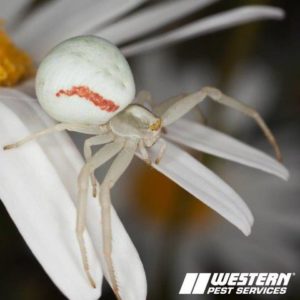Crab Spider Control: Protect Your Home or Business
Facts
- There are over 200 types of crab spiders found throughout the United States.
- Crab spiders live in a variety of habitats, including gardens, fields, and wooded areas throughout the Northeastern U.S.
- Most species are sit-and-wait hunters that stay completely still until their prey comes within reach.
- Crab spiders usually walk backward or sideways.
Appearance
Crab spiders have flattened round or oval bodies ranging from one-tenth to half an inch in length. These arachnids are unusual because they have two pairs of long front legs, which they open wide while at rest, and much shorter rear limbs.

While some crab spiders blend into their surroundings with mottled beige, brown, or black coloring, those that hunt among flowers are much brighter. In fact, two kinds of crab spiders can change their hue from white to yellow and hide among blossoms of the same color.
How Do Crab Spiders Get Inside Buildings?
It’s rare for crab spiders to come indoors. However, people may unknowingly bring them inside in potted plants or on cut flowers. Since they are small and well camouflaged, the pests can be difficult to see.
Florists and grocery stores that sell bouquets might see crab spiders arrive in their product shipments. Hotel lobbies where fresh floral arrangements are part of the decor could develop problems with these pests as well, although widespread issues are unlikely.
Signs of Crab Spider Infestation
- Egg Sacs: You may notice a protective layer of white webbing or the egg sac itself clinging to leaves or tucked between petals.
- Spiderlings: Once hatched, juvenile crab spiders often gather together in groups. Seeing a number of them all in one area can indicate an issue.
- Molting: This arachnid sheds its exoskeleton several times before reaching its full size. Finding these cast-offs suggests the presence of crab spiders.
- Adults: The most common sign is actually seeing an adult crab spider. They are solitary for the most part, but discovering one can indicate that others are nearby.
Problems Caused by Crab Spiders
Crab spiders, like most arachnids, are beneficial. They eat nuisance flies and bothersome garden pests. However, some species can disrupt pollination by preying on bees. A crab spider bite feels like a bee sting, but attacks are rare. Their venom is not dangerous to humans, but it can affect those who are allergic.
Prevention Tips
To avoid issues with these pests, inspect plants or flowers before bringing them inside. Keep entrances free from leaf litter where crab spiders like to hide, and seal any openings near windows, doors, and pipes. For further help with a crab spider issue, contact the experts at Western Pest Services.